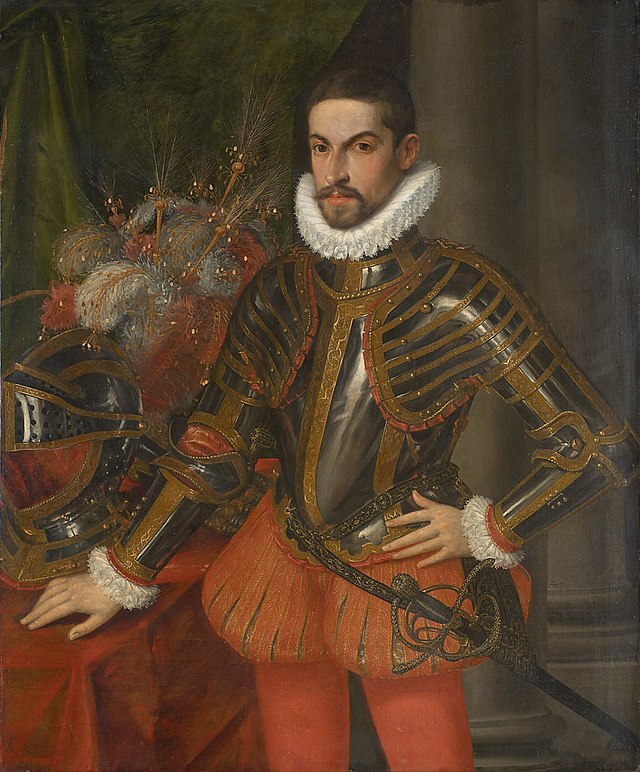Maximilian III of Austria (12 October 1558 – 2 November 1618), was a member of the House of Habsburg and the Archduke of Further Austria from 1612 until his death. He was also briefly known as Maximilian of Poland during his claim for the Polish throne. He would try to be elected as King of Poland he was defeated. He was also Grand Master of the Teutonic Order
| Maximilian III | |
|---|---|
| Grand Master of the Teutonic Order | |
 Portrait by Hans Henseiller, 1590s, National Museum in Warsaw | |
| Archduke of Further Austria | |
| Reign | 26 June 1612 – 2 November 1618 |
| Predecessor | Matthias |
| Successor | Matthias |
| King of Poland Grand Duke of Lithuania (contested) | |
| Reign | 27 September 1587 – 9 March 1589 |
| Predecessor | Stephen Báthory |
| Successor | Sigismund III Vasa |
| Born | 12 October 1558 Wiener Neustadt, Archduchy of Austria |
| Died | 2 November 1618 (aged 60) Vienna, Archduchy of Austria |
| Burial | |
| House | Habsburg |
| Father | Maximilian II, Holy Roman Emperor |
| Mother | Maria of Spain |
| Religion | Roman Catholicism |
| Signature |  |
Biography


Born in Wiener Neustadt, Maximilian was the fourth son of the Emperor Maximilian II and Maria of Spain. He was a grandson of Anna of Bohemia and Hungary, daughter and heiress of Vladislaus II of Bohemia and Hungary, who himself was the eldest son of Casimir IV of Poland from the Jagiellonian dynasty.
In 1585, Maximilian became the Grand Master of the Teutonic Order; thanks to this he was known by the epithet der Deutschmeister ("the German Master") for much of his later life.[1]
In the 1587 Polish–Lithuanian royal election Maximilian stood as a candidate for the throne of the Polish–Lithuanian Commonwealth, following the death of the previous king, Stephen Báthory. Nonetheless, a portion of the Polish nobility elected Maximilian king, but another faction elected Prince Sigismund of Sweden, grandson of Sigismund I the Old, as Sigismund III Vasa. However, he faced considerable opposition as well due to same reasons as before. Maximilian then invaded Poland, starting the War of the Polish Succession (1587–1588). He had considerable support in Poland, but fewer Poles flocked to his army than to that of his rival. In late 1587, he tried and failed to storm Kraków. At Pitschen in Silesia, he met Sigismund's army, commanded by Polish hetman Jan Zamojski. In the Battle of Byczyna (24 January 1588), Maximilian was defeated and captured. He was released a year and half later after the intervention of Pope Sixtus V in the aftermath of the Treaty of Bytom and Będzin. In 1598, he formally renounced his claim to the Polish crown.[2] The inactivity of his brother, Emperor Rudolf II, in this matter contributed to Rudolf's poor reputation.[citation needed]
From 1593 to 1595, Maximilian served as regent for his young cousin, the future Emperor Ferdinand II as Archduke of Inner Austria. In 1595, Maximilian succeeded to the territories of their uncle Ferdinand II, Archduke of Further Austria, including Tyrol, where he proved to be a solid proponent of the Counter-Reformation. He also worked to depose Melchior Khlesl, and to ensure that Ferdinand succeeded as Holy Roman Emperor.
Today, Maximilian is perhaps best remembered for his baroque archducal hat, exhibited in the treasury of the monastery of Klosterneuburg and was used for ceremonial purposes as late as 1835.
He died at Vienna in 1618, and is buried in the canopied tomb in Innsbruck Cathedral.
Ancestors
| Ancestors of Maximilian III, Archduke of Austria | |||||||||||||||||||||||||||||||||||||||||||||||||||||||||||||||||||||||||||||||||||||||||||||||||||||||||||||||||||||||||||||||||||||||||||||||||||||||||||||||||||||||||||||||||||||||||||||||||||||||||||||||||||||||||||||||||||||||||||||||||||||||||||||||||||||||||||||||||||||||||
|---|---|---|---|---|---|---|---|---|---|---|---|---|---|---|---|---|---|---|---|---|---|---|---|---|---|---|---|---|---|---|---|---|---|---|---|---|---|---|---|---|---|---|---|---|---|---|---|---|---|---|---|---|---|---|---|---|---|---|---|---|---|---|---|---|---|---|---|---|---|---|---|---|---|---|---|---|---|---|---|---|---|---|---|---|---|---|---|---|---|---|---|---|---|---|---|---|---|---|---|---|---|---|---|---|---|---|---|---|---|---|---|---|---|---|---|---|---|---|---|---|---|---|---|---|---|---|---|---|---|---|---|---|---|---|---|---|---|---|---|---|---|---|---|---|---|---|---|---|---|---|---|---|---|---|---|---|---|---|---|---|---|---|---|---|---|---|---|---|---|---|---|---|---|---|---|---|---|---|---|---|---|---|---|---|---|---|---|---|---|---|---|---|---|---|---|---|---|---|---|---|---|---|---|---|---|---|---|---|---|---|---|---|---|---|---|---|---|---|---|---|---|---|---|---|---|---|---|---|---|---|---|---|---|---|---|---|---|---|---|---|---|---|---|---|---|---|---|---|---|---|---|---|---|---|---|---|---|---|---|---|---|---|---|---|---|---|---|---|---|---|---|---|---|---|---|---|---|---|---|---|---|
| |||||||||||||||||||||||||||||||||||||||||||||||||||||||||||||||||||||||||||||||||||||||||||||||||||||||||||||||||||||||||||||||||||||||||||||||||||||||||||||||||||||||||||||||||||||||||||||||||||||||||||||||||||||||||||||||||||||||||||||||||||||||||||||||||||||||||||||||||||||||||
Male-line family tree
References
Wikiwand in your browser!
Seamless Wikipedia browsing. On steroids.
Every time you click a link to Wikipedia, Wiktionary or Wikiquote in your browser's search results, it will show the modern Wikiwand interface.
Wikiwand extension is a five stars, simple, with minimum permission required to keep your browsing private, safe and transparent.
